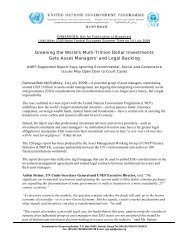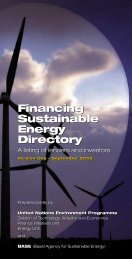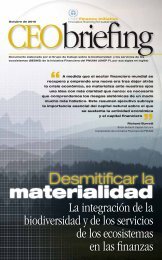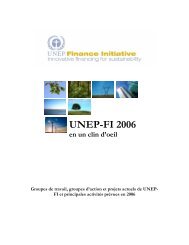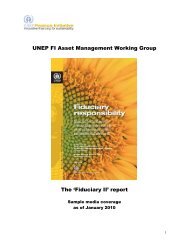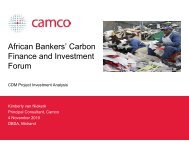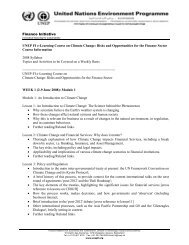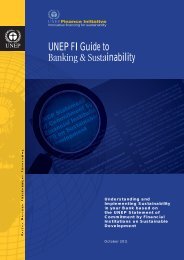Utilities & Waste Management - UNEP Finance Initiative
Utilities & Waste Management - UNEP Finance Initiative
Utilities & Waste Management - UNEP Finance Initiative
You also want an ePaper? Increase the reach of your titles
YUMPU automatically turns print PDFs into web optimized ePapers that Google loves.
<strong>Utilities</strong> & <strong>Waste</strong> <strong>Management</strong><br />
The volume of the sludge varies substantially<br />
depending on what process that has been used<br />
and depending on where in the cycle the<br />
sludge is collected. The sludge needs to be<br />
stabilised and extraction of water. The are four<br />
methods to stabilise the sludge:<br />
s<br />
s<br />
s<br />
s<br />
Anaerobic stabilisation;<br />
Aerobic stabilisation;<br />
Chemical stabilisation; and<br />
Thermal stabilisation<br />
Typically, sludges are thickened (dewatered) to<br />
reduce the volumes transported off-site for<br />
disposal (landfill). There is no process, which<br />
completely eliminates the requirements for<br />
disposal of biosolids.<br />
Tertiary Treatment<br />
Sometimes, further treatment is needed to<br />
improve the quality of the wastewater. This is<br />
known as tertiary treatment. Various methods<br />
may be used including sand filters, reed beds<br />
or grass plots. Disinfection, using ultra violet<br />
light to kill bacteria, is another method being<br />
used at a number of coastal sewage treatment<br />
schemes.<br />
Landfill<br />
Landfill refers to a method for final disposal of<br />
solid waste on land. Most modern landfills are<br />
classified according to the type(s) of waste<br />
material disposed of into them.<br />
Hazardous <strong>Waste</strong> Landfill: waste disposal units<br />
constructed to specific design criteria and<br />
which receive wastes meeting the local<br />
definition of hazardous waste. These landfills<br />
are generally constructed to be secure<br />
repositories for material that presents a serious<br />
hazard to human health.<br />
Non Hazardous Landfills: also called modern,<br />
engineered or secure landfills, these usually<br />
have physical barriers such as liners and<br />
leachate collection systems and procedures to<br />
protect the public from exposure to the<br />
disposed wastes. The term sanitary landfill<br />
normally refers to those where municipal solid<br />
waste is disposed of, as well as other wastes<br />
high in organic material. In some countries, all<br />
landfills are sanitary landfills.<br />
Inert <strong>Waste</strong> Landfill: waste disposal units that<br />
receive wastes that are chemically and<br />
physically stable and do not undergo<br />
decomposition, such as sand, bricks, concrete<br />
or gravel.<br />
Typically a landfill facility may comprise the<br />
following components:<br />
s<br />
s<br />
s<br />
s<br />
s<br />
s<br />
A bottom liner system;<br />
A leachate collection and management<br />
system;<br />
A landfill gas management system;<br />
Supporting road network.<br />
A drainage system; and<br />
A final capping system.<br />
Their function is to secure the normal landfill<br />
operations and to control the anticipated<br />
emissions generated mainly by the<br />
decomposition of organic matter, such as<br />
contaminated leachate and landfill gas.<br />
Landfill gas, which is principally methane and<br />
carbon dioxide, arises when wastes<br />
decompose and can be potentially noxious and<br />
explosive. Landfill gas can though be<br />
harnessed to provide energy.<br />
<strong>Waste</strong> Incineration<br />
Incinerators operate by feeding wastes onto a<br />
moving grate where they are burned. The heat<br />
generated raises steam, which can be used to<br />
drive turbines to generate electricity (See<br />
Power Generation and Distribution ESRB -<br />
Energy from Biomass and <strong>Waste</strong>).<br />
Four main technologies exist for the<br />
incineration of waste:



